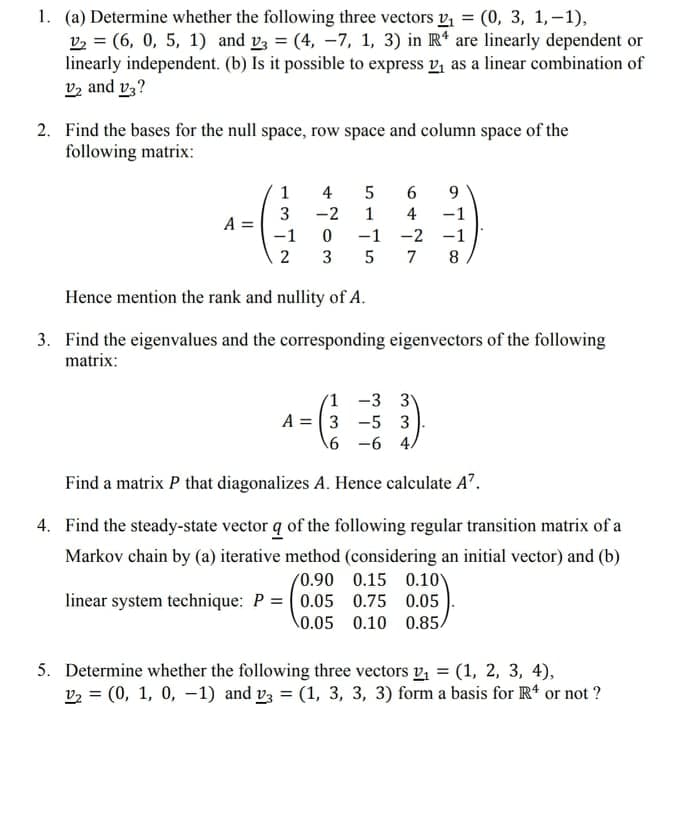1. (a) Determine whether the following three vectors v, = (0, 3, 1,-1), v2 = (6, 0, 5, 1) and vz = (4, -7, 1, 3) in R* are linearly dependent or linearly independent. (b) Is it possible to express v, as a linear combination of v2 and v3? 2. Find the bases for the null space, row space and column space of the following matrix: 1 4 5 6 -2 4 -1 A = -1 -2 -1 5 -1 2 3 7 8. Hence mention the rank and nullity of A.
1. (a) Determine whether the following three vectors v, = (0, 3, 1,-1), v2 = (6, 0, 5, 1) and vz = (4, -7, 1, 3) in R* are linearly dependent or linearly independent. (b) Is it possible to express v, as a linear combination of v2 and v3? 2. Find the bases for the null space, row space and column space of the following matrix: 1 4 5 6 -2 4 -1 A = -1 -2 -1 5 -1 2 3 7 8. Hence mention the rank and nullity of A.
Linear Algebra: A Modern Introduction
4th Edition
ISBN:9781285463247
Author:David Poole
Publisher:David Poole
Chapter6: Vector Spaces
Section6.6: The Matrix Of A Linear Transformation
Problem 7AEXP
Related questions
Question

Transcribed Image Text:1. (a) Determine whether the following three vectors v, = (0, 3, 1,–1),
V2 = (6, 0, 5, 1) and v3 = (4, -7, 1, 3) in R* are linearly dependent or
linearly independent. (b) Is it possible to express v, as a linear combination of
vz and v3?
2. Find the bases for the null space, row space and column space of the
following matrix:
1
4
9.
3
A =
-1
-2
4
-1
-1 -2 -1
2
7
8.
Hence mention the rank and nullity of A.
3. Find the eigenvalues and the corresponding eigenvectors of the following
matrix:
1 -3 3
A = 3 -5 3
\6 -6 4/
Find a matrix P that diagonalizes A. Hence calculate A7.
4. Find the steady-state vector q of the following regular transition matrix of a
Markov chain by (a) iterative method (considering an initial vector) and (b)
(0.90 0.15 0.10)
linear system technique: P = 0.05 0.75 0.05
0.05 0.10 0.85/
5. Determine whether the following three vectors v, = (1, 2, 3, 4),
V2 = (0, 1, 0, –1) and vz = (1, 3, 3, 3) form a basis for R* or not ?
Expert Solution
This question has been solved!
Explore an expertly crafted, step-by-step solution for a thorough understanding of key concepts.
Step by step
Solved in 3 steps with 6 images

Knowledge Booster
Learn more about
Need a deep-dive on the concept behind this application? Look no further. Learn more about this topic, calculus and related others by exploring similar questions and additional content below.Recommended textbooks for you

Linear Algebra: A Modern Introduction
Algebra
ISBN:
9781285463247
Author:
David Poole
Publisher:
Cengage Learning

Elementary Linear Algebra (MindTap Course List)
Algebra
ISBN:
9781305658004
Author:
Ron Larson
Publisher:
Cengage Learning

Algebra & Trigonometry with Analytic Geometry
Algebra
ISBN:
9781133382119
Author:
Swokowski
Publisher:
Cengage

Linear Algebra: A Modern Introduction
Algebra
ISBN:
9781285463247
Author:
David Poole
Publisher:
Cengage Learning

Elementary Linear Algebra (MindTap Course List)
Algebra
ISBN:
9781305658004
Author:
Ron Larson
Publisher:
Cengage Learning

Algebra & Trigonometry with Analytic Geometry
Algebra
ISBN:
9781133382119
Author:
Swokowski
Publisher:
Cengage